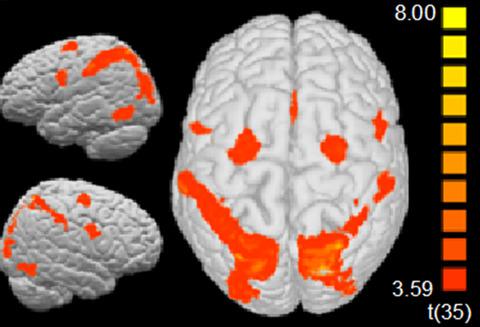Our official English website, www.x-mol.net, welcomes your
feedback! (Note: you will need to create a separate account there.)
Development of bilateral parietal activation for complex visual-spatial function: Evidence from a visual-spatial construction task
Developmental Science ( IF 3.1 ) Pub Date : 2020-11-23 , DOI: 10.1111/desc.13067 Katrina Ferrara 1 , Anna Seydell-Greenwald 1 , Catherine E Chambers 1 , Elissa L Newport 1 , Barbara Landau 1, 2
Developmental Science ( IF 3.1 ) Pub Date : 2020-11-23 , DOI: 10.1111/desc.13067 Katrina Ferrara 1 , Anna Seydell-Greenwald 1 , Catherine E Chambers 1 , Elissa L Newport 1 , Barbara Landau 1, 2
Affiliation

|
The neural representation of visual-spatial functions has traditionally been ascribed to the right hemisphere, but little is known about these representations in children, including whether and how lateralization of function changes over the course of development. Some studies suggest bilateral activation early in life that develops toward right-lateralization in adulthood, while others find evidence of right-hemispheric dominance in both children and adults. We used a complex visual-spatial construction task to examine the nature of lateralization and its developmental time course in children ages 5–11 years. Participants were shown two puzzle pieces and were asked whether the pieces could fit together to make a square; responses required either mental translation of the pieces (Translation condition) or both mental translation and rotation of the pieces (Rotation condition). Both conditions were compared to a matched Luminance control condition that was similar in terms of visual content and difficulty but required no spatial analysis. Group and single-subject analyses revealed that the Rotation and Translation conditions elicited strongly bilateral activation in the same parietal and occipital locations as have been previously found for adults. These findings show that visual-spatial construction consistently elicits robust bilateral activation from age 5 through adulthood. This challenges the idea that spatial functions are all right-lateralized, either during early development or in adulthood. More generally, these findings provide insights into the developmental course of lateralization across different spatial skills and how this may be influenced by the computational requirements of the particular functions involved.
中文翻译:

复杂视觉空间功能的双侧顶叶激活的发展:来自视觉空间构建任务的证据
视觉空间功能的神经表征传统上被认为是右半球,但人们对儿童的这些表征知之甚少,包括功能的偏侧化在发育过程中是否以及如何变化。一些研究表明,生命早期的双侧激活在成年后会发展为右半球,而其他研究则发现儿童和成人中右半球占主导地位的证据。我们使用复杂的视觉空间构建任务来研究 5-11 岁儿童偏侧化的本质及其发展时间过程。向参与者展示两块拼图,并询问这些拼图是否可以拼成一个正方形;响应需要棋子的心理平移(平移条件)或棋子的心理平移和旋转(旋转条件)。将这两种条件与匹配的亮度控制条件进行比较,后者在视觉内容和难度方面相似,但不需要空间分析。小组和单个受试者分析显示,旋转和平移条件在与先前在成人中发现的相同的顶叶和枕叶位置引起强烈的双侧激活。这些发现表明,从 5 岁到成年,视觉空间构建始终会引起强烈的双侧激活。这挑战了空间功能无论是在早期发育还是在成年期都是右偏的这一观点。更一般地说,这些发现提供了对不同空间技能的侧化发展过程的见解,以及它如何受到所涉及的特定功能的计算要求的影响。
更新日期:2020-11-23
中文翻译:

复杂视觉空间功能的双侧顶叶激活的发展:来自视觉空间构建任务的证据
视觉空间功能的神经表征传统上被认为是右半球,但人们对儿童的这些表征知之甚少,包括功能的偏侧化在发育过程中是否以及如何变化。一些研究表明,生命早期的双侧激活在成年后会发展为右半球,而其他研究则发现儿童和成人中右半球占主导地位的证据。我们使用复杂的视觉空间构建任务来研究 5-11 岁儿童偏侧化的本质及其发展时间过程。向参与者展示两块拼图,并询问这些拼图是否可以拼成一个正方形;响应需要棋子的心理平移(平移条件)或棋子的心理平移和旋转(旋转条件)。将这两种条件与匹配的亮度控制条件进行比较,后者在视觉内容和难度方面相似,但不需要空间分析。小组和单个受试者分析显示,旋转和平移条件在与先前在成人中发现的相同的顶叶和枕叶位置引起强烈的双侧激活。这些发现表明,从 5 岁到成年,视觉空间构建始终会引起强烈的双侧激活。这挑战了空间功能无论是在早期发育还是在成年期都是右偏的这一观点。更一般地说,这些发现提供了对不同空间技能的侧化发展过程的见解,以及它如何受到所涉及的特定功能的计算要求的影响。











































 京公网安备 11010802027423号
京公网安备 11010802027423号